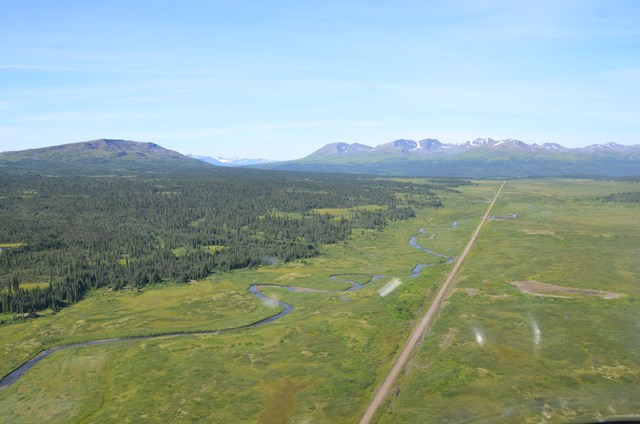Fortune Minerals Limited ("Fortune" or the "Company") and POSCO Canada Ltd. ("POSCAN") are pleased to announce that their Arctos Anthracite Joint Venture ("AAJV") has submitted a revised Project Description for the Arctos Anthracite Project to the British Columbia Environmental Assessment Office ("BCEAO") and the Canadian Environmental Assessment Agency ("CEAA").
 The Arctos Anthracite Project straddles the existing BC Railway right-of-way in northwest British Columbia, Canada. (CNW Group/Fortune Minerals Limited
The Arctos Anthracite Project straddles the existing BC Railway right-of-way in northwest British Columbia, Canada. (CNW Group/Fortune Minerals Limited
This revised Project Description is based on the current development plan that includes extending the Dease Lake railway line in northwest British Columbia ("BC"), 150 km to the proposed mine along the existing railway roadbed. The mine plan has also been amended to reflect a three million tonne per annum production rate and to include modifications to reduce environmental impacts. The CEAA has accepted the Project Description and is seeking public comment on the environmental assessment ("EA") process.
The BCEAO has issued a Section 10 order that determines that the project is reviewable and requires an EA to proceed. The BCEAO has also submitted a request to the CEAA for "substitution", which would streamline the EA process under a single regulatory body in BC, making the EA more efficient with the elimination of unnecessary duplication. A decision on substitution is expected from the CEAA by late May. If the request is approved by the federal Minister of Environment, the province would commit to fulfill the conditions for substitution which includes undertaking procedural delegation of aboriginal consultation for the project.
Dr. Richard Schryer , Fortune's Director of Regulatory and Environmental Affairs, commented, "substitution of the federal EA process enables cooperation between jurisdictions in the delivery of timely, high quality EAs to achieve the objective of a 'one project-one assessment' approach".
The AAJV had already been in the EA process for a previous development plan and most of the environmental baseline information for the mine site has already been collected. The AAJV has been conducting significant additional environmental baseline studies for the proposed railway extension and to address gaps and update the mine baseline data to support permitting and detailed engineering designs. The AAJV is also targeting submission of its draft Application Information Requirements ("dAIR") or "Terms of Reference" in May. The final EA report is expected to be filed in early 2014 to initiate the review process.
Project overview:
The Arctos Anthracite Project is one of the world's premier metallurgical coal projects consisting of 16,411 hectares of contiguous coal licenses in northwest BC. The project is an international collaboration between Fortune (80%) and POSCAN (20%), the Canadian subsidiary of South Korea's POSCO, one of the world's largest steel producers. Substantial engineering, feasibility and environmental work have already been completed for the proposed development, with expenditures to date totalling approximately $100 million.
The Arctos project is located 330 km northeast of the Port of Prince Rupert and straddles the existing BC Railway right-of-way. The roadbed for this railway was constructed in the 1970's by the BC government, but was never completed from the current terminus of track, 150 km south of the proposed mine. The railway right-of-way provides a simple brownfield access corridor to the Canadian National Railway at Minaret, and from there, to the Ridley Coal Terminal in Prince Rupert for export of metallurgical coal products to overseas steel manufacturers and metal processors. Based on the recently updated definitive feasibility study for the Arctos project, the Proven and Probable Run-of-Mine Product Reserves will support a 25-year mine life, contributing 500 direct jobs and 1000 jobs in supporting activities and generating more than $10 billion in revenues and $900 million in combined federal and provincial taxes. Further, there is an opportunity to extend the mine life from a very large mineral resource base.
Anthracite coal:
Anthracite is the highest quality metallurgical coal, measured by carbon and energy content, and represents just 1% of world coal reserves. It is also the most versatile coal, suitable for use in a broad range of steel making and metallurgical processes and as a raw material to manufacture synthetic products. The natural high carbon and very low volatile (gas) content of anthracite makes it ideal for use as a premium ultra-low volatile pulverized coal injection ("PCI") product that is injected into the blast furnace to reduce the amount of coke used in crude steel production. High carbon and low volatiles also allows anthracite to be used as a direct coke replacement and as a blend coal to make metallurgical coke that is typically made from hard coking coal. Anthracite is the only coal that can be used as sinter feed. Anthracite reductants are used in electric arc / direct reduction steel manufacturing and for the processing of ferroalloys and other metals. Carbon filters for water purification are made with anthracite coal as well as some carbon composite materials. The high carbon content of anthracite makes it the preferred coal for gasification and liquefaction technologies to make urea fertilizers, plastics and high quality synthetic fuels, particularly in Asia where natural gas supplies are scarce.
The global shortage of high quality metallurgical coal is driving innovation in the steel industry as producers develop new technologies to be globally competitive, reduce greenhouse gas emissions, and diversify their sources of key raw materials. Many of these new technologies use even greater amounts of anthracite. The scarcity of high quality deposits and declining exports from the traditional suppliers highlights the importance of having a reliable Canadian source.
The disclosure of scientific and technical information contained in this press release has been approved by Robin Goad , M.Sc., P.Geo., President and Chief Executive Officer of the Company, who is a "qualified person" under National Instrument 43-101.